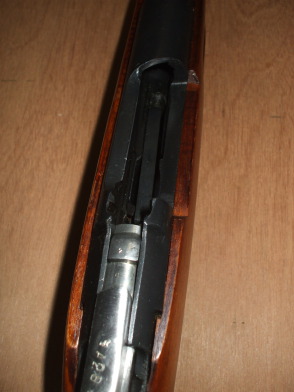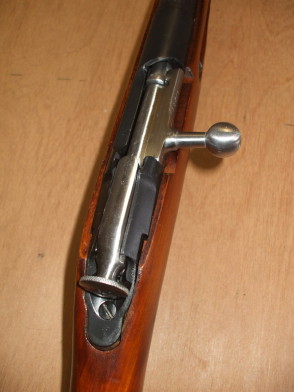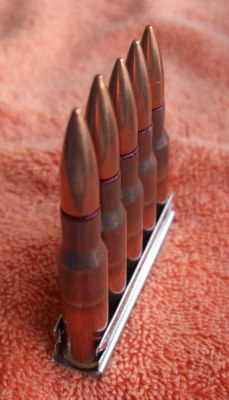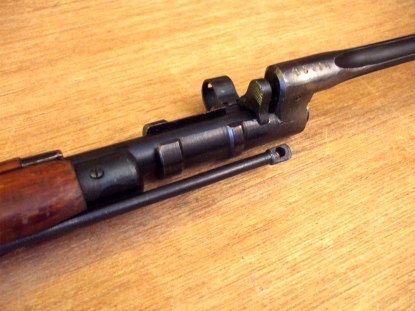
Винтовка Мосина, Vintovka Mosina or "Three-Line" Rifle
The Mosin-Nagant Rifle
The Mosin-Nagant rifle is a bolt-action military rifle developed in 1882-1891 and used by the Russian Imperial Army, the Soviet Union's military forces, and many other nations around the world. Used with telescopic sights, it is still in service with the armies of Afghanistan and Iraq. The 7.62 Tarkkuuskivääri 85 is a rifle used by designated marksmen and snipers in the Finnish Defence Forces, it is based on the Mosin-Nagant and some are built using the original receivers and other parts dating back to the 1890s.
Origins: The Mosin-Nagant-Zinoviev Design Competition
The Russian Empire's forces suffered heavy casualties during the Russo-Turkish War of 1877-1878. They were using single-shot Berdan rifles against Ottoman Turkish troops armed with Winchester repeating rifles. Russian forces prevailed, but with heavy losses. Russia needed a more modern infantry rifle.
The Tsar's Artillery Administration began a project to develop a replacement in 1882. They were unable to satisfactorily modify the existing Berdan design, and formed a commission to test new designs.
Russian arms terminology of the time defined caliber in terms of линия or liniya. The liniya was 1/10th of a дюйм or dyum, a unit redefined by Peter the Great as being exactly one English inch. So, to the Imperial Russians, три линиы or "3-line" meant precisely 0.3" or 7.62mm.
Sergei Ivanovich Mosin, an Imperial Army captain, submitted a 3-line rifle design in 1889. The Belgian arms designer Léon Nagant submitted a 3.5-line rifle design. A third design was submitted by Russian captain Zinoviev but was quickly ruled out.
The commission initially favored Nagant's design, but he was Belgian and not Russian. Further testing was done, in which Mosin's design (to great surprise) was found the winner.
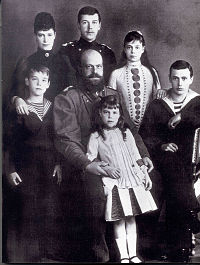
Aleksandr III, Tsar of Russia 1881-1894.
Mosin was originally from Voronezh Oblast. He had entered a military academy at age 12. At 18 he entered the Alexandrovskoye Military High School in Moscow. Three years later he transferred to the Mikhailovskoye Artillery Academy. He graduated from there, transferred to the Tula Arsenal and became head of its machining division.
Mosin's rifle design was adopted in 1891. It incorporated a few details from Nagant's design: a clip making it easier to load five cartridges into the magazine, and the attachment of the magazine spring to the base plate of the magazine.
Another crucial borrowing was the "interrupter", a modification to the feed mechanism to prevent double-feed failures, stoppages caused by an attempt for two cartridges to load simultaneously. Nagant's initial rifle design had not had an interrupter, he had borrowed that detail from Mosin's design. The commission borrowed that back again.
M1891/30 Винтовка Мосина
Mosin's original design was officially known as the 3-line rifle, Model 1891. It was produced during Tsarist days by the arsenals at Tula, Izhevsk and Sestroryetsk, and an additional 500,000 were ordered from the French arms factory Manufacture Nationale d'Armes de Châtellerault.
There were a number of modifications to the design over time. The most common variant was the M1891/30, designed in 1930 after the Russian Revolution had replaced the Tsar's Russian Empire with Lenin's Soviet Union. The 1930 redesign changed the interrupter because the dual-feed jamming was still the biggest problem with the design.
The rear sight was also recalibrated for distances in meters instead of the older Russian measure of аршины or arshins, those being 28 English inches or 71.12 cm. The front sight was changed from a simple blade to a hooded post adjustable for elevation.
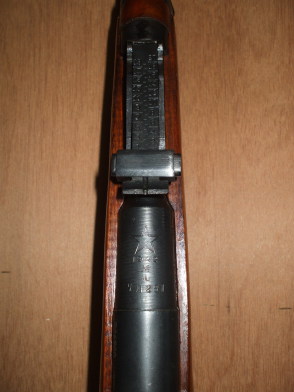
Rear sight and Izhevsk arsenal mark.
Hardly anything of Nagant's design was left — just the magazine spring and the very infrequently used loading clip. Nagant tried to publicize the name "Mosin-Nagant" and it did appear in western literature. The Russians called it the M1891/30 or the Винтовка Мосина, the Vintovka Mosina, the Rifle of Mosin or Mosin's Rifle. Or, as a diminutive nickname, the Мосинка or Mosinka.
The M1891/30 is 3.5" shorter than the original 1891 design, but it is still 48.25" long, or 65.25" with the bayonet mounted! That's 1.72 and 2.33 arshini if you still use the traditional units of measure.
The next-to-top cartridge in line in the magazine is retained by a bolt-activated interrupter projecting from the left inner wall of the receiver. The follower does not press against the round being chambered. That round simply lies on top of the stack until the bolt picks it up and chambers it.
The Mosin rifle was used by Imperial Russia in 1904 in the Russo-Japanese War. Variants were used by Finland, a Grand Duchy in the Russian Empire until 1917.
Russia ordered M1891 infantry rifles from U.S. manufacturers at the beginning of World War I — 1,500,000 from Remington Arms and 1,800,000 from New England Westinghouse. Remington had produced 750,000 rifles before Russia's 1917 October Revolution halted production. 469,951 had been delivered, and the remaining 280,000 were purchased by the U.S. Army and designated as "U.S. Rifle, 7.62mm, Model of 1916". Some were issued to the U.S. and British Expeditionary Forces sent to Murmansk and Arkhangelsk in the late summer of 1918, 50,000 were sent through Vladivostok to the Czechoslovak Legions in Siberia, and others went to National Guard and ROTC units. Many were sold to private citizens in the U.S. for $3 each through the Director of Civilian Marksmanship program before World War II.
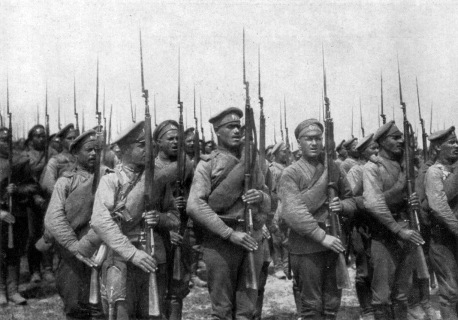
Russian Imperial infantry armed with 2.33 arshini Mosin rifles in World War I.
M1891/30 and other variants were produced and used in large numbers by the Soviet Union during the Great Patriotic War, also known as World War II. About 17,475,000 M1891/30 rifles were built.
Versions were also produced in Finland, leading to it being used by both sides in the 1939-1940 Winter War and what is called the Continuation War during World War II.
Before World War II, in 1936-1939, the rifles were sent as aid to the anti-Franco forces in the Spanish Civil War. The Mosin rifle and its variants were then used by many Warsaw Pact and other Soviet-supported countries through the Cold War.
Insurgent forces in Iraq have used it through the early 2000s, and it is still in use in Afghanistan some 133 years after Sergei Ivanovich Mosin designed it.

The magazine can be emptied easily by releasing the magazine floor plate catch. This provides a method for dumping your ammunition onto the ground if you aren't careful.

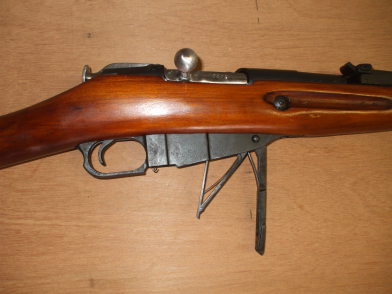
The cocking knob at the rear of the bolt also functions as the safety.
You place the rifle on safe by pulling that knob to the rear, rotating it 45° to the left and hooking it on the left rear of the receiver. This locks back the firing pin, locks the bolt closed and disengages the trigger.
The top picture shows the rifle on safe.
The middle picture shows the rifle cocked and ready to fire.
The bottom picture shows the rifle after the trigger has been pulled to fire it. Notice that the cocking piece has moved forward, pressing the firing pin through the bolt and into the primer of the cartridge.
In more detail, when the cocking knob is pulled back slightly, it draws the attached striker back far enough that its flat surfaces can rotate out of the connecting bar cylinder, allowing the cocking knob and striker to rotate to the left. As this happens, a lug on the underside of the cocking knob turns into a locking recess at the rear of the bolt.
So, the cocking piece has rotated out of contact with the sear and a trigger pull cannot release it. With the striker rotated, it cannot more forward within the bar cylinder and so it cannot reach the primer. The lug on the bottom of the cocking piece is locked into a notch in the rear of the bolt, preventing forward movement. Finally, the forward extension on the cocking piece is caught on the receiver and must be moved back against strong spring resistance before it can be rotated back to the right and the safety disengaged.
The result is a safety that is positive, extremely effective, but rather difficult to manipulate. With the safety engaged the gun simply cannot be fired. However, the mechanical difficulty of manipulating the safety probably makes for a risk that an accidental discharge can happen immediately upon disengaging the safety as the gun was awkwardly grasped and the trigger inadvertently touched after wrestling with the strongly sprung safety.
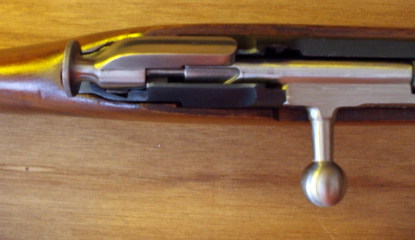
Safe. Knob is rotated 45° to the left.
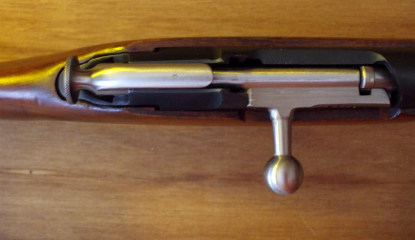
Cocked and ready to fire.
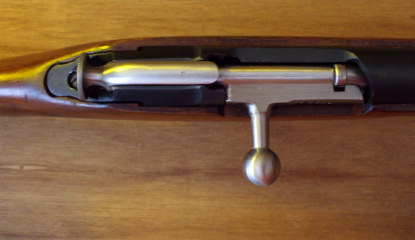
Rifle has fired.
To remove the bolt, start by opening the floor plate of the magazine and dumping any ammunition onto the ground. Once you are certain that the gun is unloaded, rotate the bolt handle up and draw the bolt all the way back. Pull the trigger, moving the bolt slightly forward and then back and out of the receiver.
To field-strip the bolt, start with it as drawn out of the rear of the receiver, as seen in the first picture.
Holding the cocking piece in your left hand, rotate the bolt handle and main bolt body 90° toward you, as seen in the second picture.
The bolt handle, main bolt body, firing pin and cocking piece can be lifted off the bolt head and firing pin guide bar, as seen in the third picture.
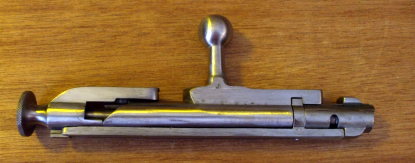
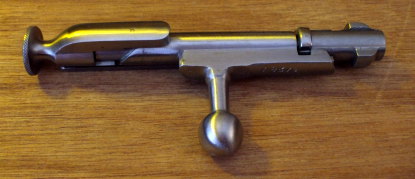

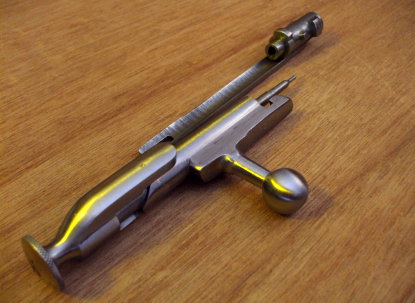

As you can see in the last two pictures above and this full-sized picture, you will find some rough machining on internal components of some wartime rifles. This rifle was manufactured in 1942 in Izhevsk.
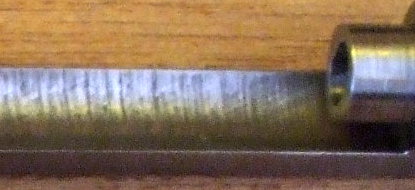
The rear sight of an M1891/30 is calibrated in
hundreds of arshini.
Divide arshini by 1.406 to get meters.
1 аршин = 0.7112 meter
1 meter = 1.406 аршин
| "1" | 100 аршин | 71 meters |
| "2" | 200 аршин | 142 meters |
| "3" | 300 аршин | 213 meters |
| "4" | 400 аршин | 284 meters |
| "5" | 500 аршин | 356 meters |
| "6" | 600 аршин | 427 meters |
| "7" | 700 аршин | 498 meters |
| "8" | 800 аршин | 569 meters |
| "9" | 900 аршин | 640 meters |
| "10" | 1000 аршин | 711 meters |
| "11" | 1100 аршин | 782 meters |
| "12" | 1200 аршин | 853 meters |
| "13" | 1300 аршин | 925 meters |
| "14" | 1400 аршин | 996 meters |
| "15" | 1500 аршин | 1067 meters |
| "16" | 1600 аршин | 1138 meters |
| "17" | 1700 аршин | 1209 meters |
| "18" | 1800 аршин | 1280 meters |
| "19" | 1900 аршин | 1351 meters |
| "20" | 2000 аршин | 1422 meters |

With the slide all the way back, it is at the "Battle" setting, marked by П. That actually raises the rear sight, raising the trajectory, but in the heat of battle it is useful from point-blank range out to 200 to 300 meters.
The front sight was originally a simple exposed blade in the original 1891 design. The 1930 redesign changed this to a post inside a cylindrical hood.
The front side can be adjusted for elevation by screwing the front post up and down with a special tool, but this is seldom needed.
It is much more likely that adjustment for windage will be needed. This is done by drifting the front side left or right. You can see a slight overhang on the right side of this sight, where it has been drifted slightly to the right in order to correct impact to the left.
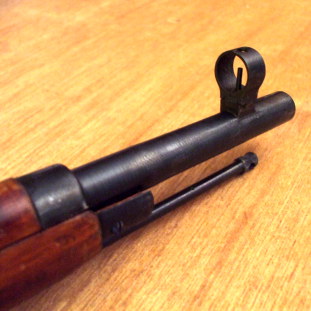
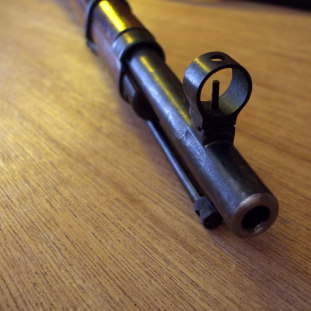
The 1930 redesigned bayonet is, roughly speaking, a thin spike.
Looking closer, it has a cross-shaped cross section. The front tip is like a straight-blade screwdriver.
It mounts onto the muzzle by pressing it on with the bayonet spike directly above the barrel. Then rotate it 90° so the notch goes around the front sight.
The spring-loaded button will pop out when it is fully rotated into place. You must press that button back forward into the bayonet in order to rotate it back for removal.
If all the pieces stayed together, the serial number on the bayonet will match the four on the rifle: on the top rear of the barrel, on the bolt, on the magazine floor plate and on the butt plate.
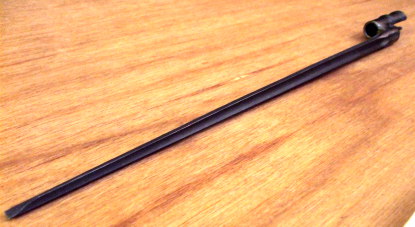
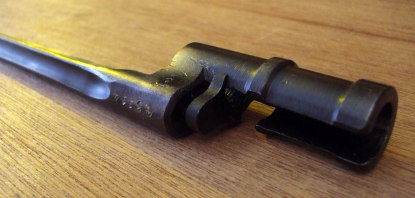
A sniper version was adopted by the Soviet military in 1932. It was issued with a 3.5-power telescopic sight and served prominently, making heroes of snipers like Vasili Zaitsev and Ivan Sidorenko.
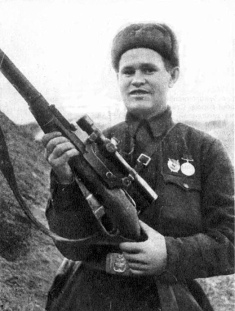
Василий Григорьевич Зайцев
Василий Григорьевич Зайцев or Vasily Grigoryevich Zaytsev grew up in the Ural Mountains, where his grandfather taught him marksmanship as they hunted deer and wolves. He is said to have killed his first wolf when he was five.
He served in the Soviet Navy as a clerk in Vladivostok. When Germany invaded the Soviet Union, Zaytsev joined many of his comrades in volunteering for transfer to the front lines. On September 22, 1942, he crossed the Volga River and joined the 1047th Rifle Regiment of the 284th Rifle Division of the 62nd Army.
One day his commanding officer called his attention to a German soldier visible in a window some 800 meters away. Zaytsev hit him with one shot using his standard issue M1891/30. Two more German soldiers appeared at the window, checking on their suddenly fallen officer, and Zaytsev killed them with one shot each.
Vasily Zaytsev was issued a sniper rifle and turned loose on the Nazis. Between October 1942 and January 1943, during the Battle of Stalingrad, he made 242 verified kills including 11 enemy snipers.
Zaytsev established and ran a sniper school. The 62nd Army began a "sniper movement", with conferences to spread the doctrine of "sniperism" and exchanges ideas not only on marksmanship but also on other supporting techniques. One of these is the use of a spotter, of a sniper being half of a two-person team. Zaytsev's technique at Stalingrad, using three two-person teams to cover a large area, came to be known as the "sixes" and is still in use today. The U.S. military's FM 3-0.5.222, Special Forces Sniper Training and Employment, says in its first chapter:
Snipers conduct missions in pairs to enhance the team's effectiveness, provide mutual security, and maintain constant support for each other. Due to lowered stress, sniper pairs can engage targets more rapidly and stay in the field for longer periods of time than a single sniper due to lowered stress.
The more experienced of the pair will act as the observer during the shot. This method is especially important on a high priority target. The more experienced sniper is better able to read winds and give the shooter a compensated aim point to ensure a first-round hit. [....]
Past experience has shown that deploying as a sniper/observer team significantly increases the success rate of the missions. With few exceptions, snipers who are deployed singly have shown a marked decrease in their effectiveness and performance almost immediately after the start of the mission. This decrease is due to the sniper becoming overwhelmed with concern for his security, the tasks to be accomplished, and his own emotions (fear, loneliness).
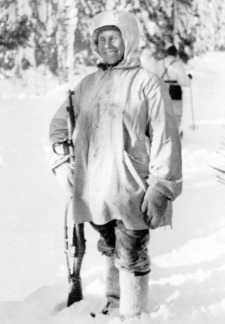
Simo Häyaä, Valkoinen kuolema.
The family name Zaytsev is based on the word заяц meaning "hare". Vasily's apprentice snipers were called зайчата or "little hares". His 28 "little hares" killed between 1000 and 3000 enemy soldiers during the war.
The movie Enemy at the Gate is based rather loosely on Vasily Zaytsev. The story shown in the film is mostly fictional. It seems to have offended most every nationality — Russians for depicting Soviet soldiers as drunken hooligans, Germans for suggesting that Germany had anything to do with the war, and Americans for its lack of even one American hero or Soviet villain.
Simo Häyhä was a Finnish sniper who killed even more enemy soldiers with a Mosin rifle. He was a sniper with the Finnish Army, fighting the Soviet Red Army during the Winter War of 1939-1940. During a period of just 100 days with very short hours of daylight and temperatures from –20 °C down to –40 °C, he was credited with 505 confirmed kills of Soviet soldiers using a Finnish militia variant of the Mosin Nagant, the M/28 "Pystykorva". He also killed over 200 with a Suomi KP/-31 submachine gun. For this the Soviets called him Белая смерть or Belaya Smert, "White Death". Or, to the Finns, Valkoinen kuolema.
Häyhä used iron sights rather than a telescopic sight for three reasons — the sniper's head is lower presenting a smaller target to the enemy, better reliability in extremely cold weather, and concealment by avoiding reflection from glass lenses.
Other pages:
Here are some excellent pages about the markings and determining if a Mosin-Nagant is all original or if it has been through refurbishment: an M1891/30 rifle, a M1938 carbine, plus lots more details at the 7.62x54r.net site.
Conscripts! Wrap Your Portyanki!
If you're going to be firing a Mosin-Nagant, you really should be wearing traditional Russian portyanki.
Click here to learn more!
